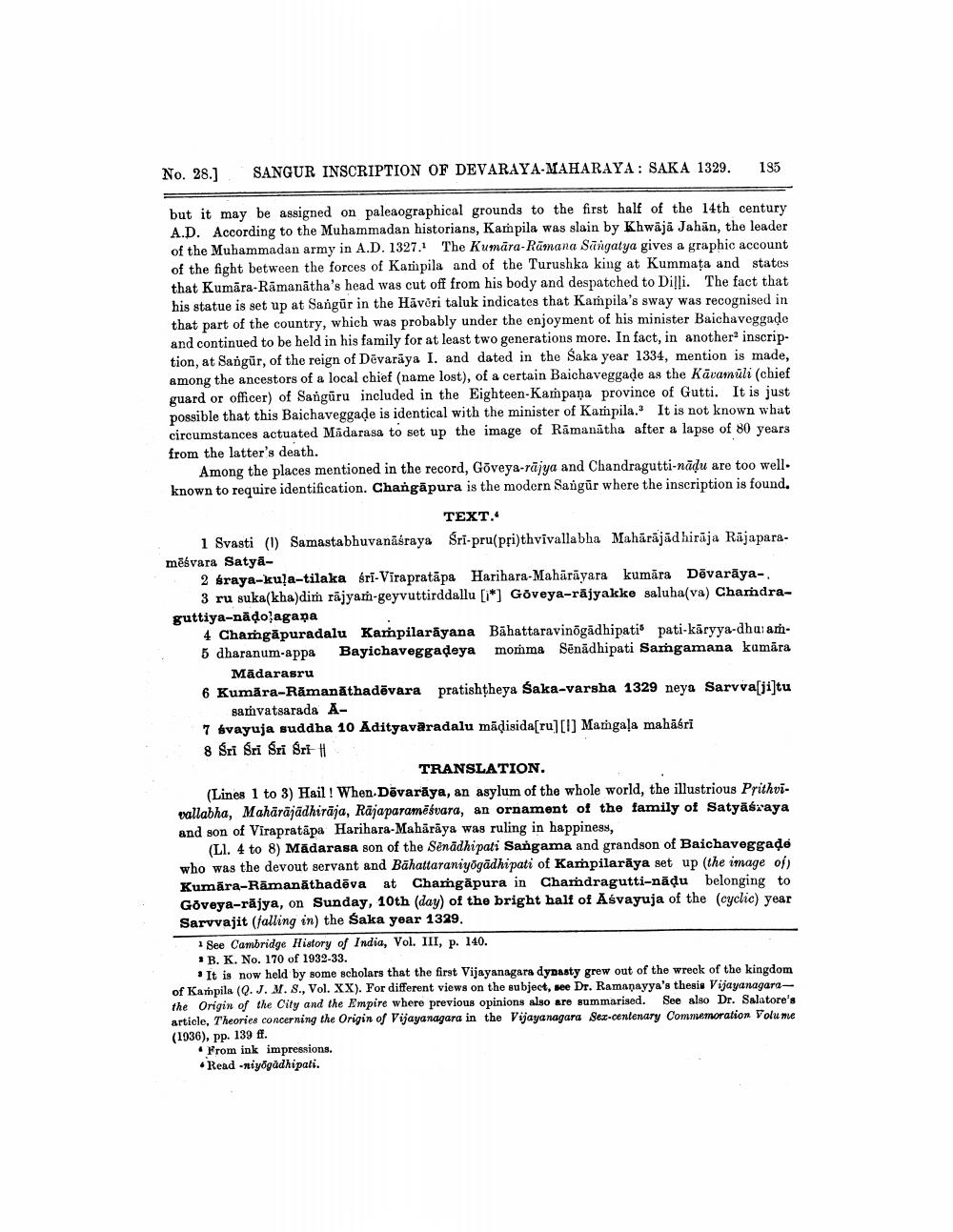________________
No. 28.]
SANGUR INSCRIPTION OF DEVARAYA-MAHARAYA: SAKA 1329.
135
but it may be assigned on paleaographical grounds to the first half of the 14th century A.D. According to the Muhammadan historians, Kampila was slain by Khwaja Jahan, the leader of the Muhammadan army in A.D. 1327. The Kumāra-Rāmana Sangatya gives a graphic account of the fight between the forces of Kampila and of the Turushka king at Kummata and states that Kumāra-Rāmanātha's head was cut off from his body and despatched to Dilli. The fact that his statue is set up at Sangür in the Hāvīri taluk indicates that Kampila's sway was recognised in that part of the country, which was probably under the enjoyment of his minister Baichaveggade and continued to be held in his family for at least two generations more. In fact, in another inscription, at Sangūr, of the reign of Devaraya I. and dated in the Saka year 1334, mention is made, among the ancestors of a local chief (name lost), of a certain Baichaveggade as the Kāvanāli (chief guard or officer) of Sangūru included in the Eighteen-Kampaņa province of Gutti. It is just possible that this Baichaveggade is identical with the minister of Kampila. It is not known what circumstances actuated Madarasa to set up the image of Rāmanātha after a lapse of 80 years from the latter's death.
Among the places mentioned in the record, Goveya-rājya and Chandragutti-nādu are too well. known to require identification. Changāpura is the modern Sangür where the inscription is found.
TEXT.: 1 Svasti (1) Samastabhuvanāśraya Sri-pru(pri)thvivallabha Mahārājād hirāja Rūjaparamēsvara Satya
2 śraya-kuļa-tilaka sri-Virapratāpa Harihara-Mahārāyara kumāra Dēvarāya
3 ru sukakha)dim rajyam-geyvuttirddallu [i*] Goveya-rajyakke saluha(va) Chandraguttiya-nādo agaña
4 Chamgapuradalu Kampilarāyana Bähattaravinogādhipati pati-kāryya-dha am5 dharanum-appa Bayichaveggadeya momma Sēnādhipati Samgamana kamāra
Mādarasru 6 Kumāra-Ramanathadëvara pratishtheya Saka-varsha 1329 neya Sarvva[ji]tu
samvatsarada A7 svayuja suddha 10 Adityavāradalu mādisida[ru] [I] Mangaļa mahabri 8 Sri Sri Sri Sri
TRANSLATION (Lines 1 to 3) Hail! When. Dāvarāya, an asylum of the whole world, the illustrious Prithvivallabha, Mahārājādhiraja, Rajaparamēšvara, an ornament of the family of Satyāśraya and son of Virapratāpa Harihara-Mahārāya was ruling in happiness,
(LI. 4 to 8) Mādarasa son of the Senādhipati Sangama and grandson of Baichaveggade who was the devout servant and Bāhattaraniyogādhipati of Kampilarāya set up (the image of Kumāra-Rāmanāthadēva at Chamgāpura in Chandragutti-nädu belonging to Goveya-rājya, on Sunday, 10th (day) of the bright half of Aśvayuja of the (cyclic) year Sarvvajit (falling in the Saka year 1329.
See Cambridge History of India, Vol. III, p. 140.
B. K. No. 170 of 1932-33.
• It is now held by some scholars that the first Vijayanagara dynasty grew out of the wreck of the kingdom of Kampila (Q.J.M.S., Vol. XX). For different views on the subject, see Dr. Ramanayya's thesis Vijayanagarathe Origin of the City and the Empire where previous opinions also are summarised. See also Dr. Salatore's article, Theories concerning the Origin of Vijayanagara in the Vijayanagara Sex-centenary Commemoration Volume (1936), pp. 139 ff.
. From ink impressions. • Read -riyogadhipati.




